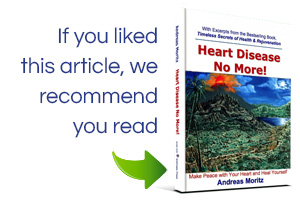By Andreas Moritz
To illustrate the development of heart disease from virtual non-existence to being the biggest killer disease, I have used statistical trends describing disease development in Germany – a typical, modern industrialized nation.
In the year 1800, meat consumption in Germany was about 13 kg (28 pounds) per person per year. One hundred years later, meat consumption was nearly three times as high, at 38 kg per person per year. By 1979, it had reached 94.2 kg, which is an increase of 725 percent in less than 180 years. These figures do not include fats. During the period of 1946-1978, meat consumption in Germany increased by 90% and heart attacks rose by 20 times. During the same period, fat consumption remained the same, whereas consumption of cereals and potatoes, which are major suppliers of vegetable protein, decreased by 45%. Therefore, fats and carbohydrates, as well as vegetable proteins, cannot be considered to be causes of coronary heart disease. This leaves meat as the main factor responsible for the dramatic upsurge of this degenerative blood vessel disease.
In consideration of the fact that at least 50 percent of the German population is overweight and most overweight people eat much more meat than those with normal weight do, meat consumption among the overweight must have at least quadrupled in the 33 years after World War II. Being overweight is considered to be a major risk for high blood pressure and heart disease.
According to statistics published by the World Health Organization (WHO) in 1978, the yearly increases of heart attacks in Western European countries were accompanied by a continuous yearly increase in meat consumption by as much as 4 kg per person. This practically means that eating habits after World War II have shifted from a healthy mixed diet to one excessive in animal protein, but poor in carbohydrates such as fruits, vegetables and grains. According to the WHO, fat consumption remained virtually unchanged. Heart attacks and atherosclerosis began to increase dramatically in Germany and in Western industrialized nations soon after the war; today they cause over 50 percent of all deaths.
Although fat consumption among vegetarians is not less than among meat eaters, the vegetarians have the lowest death rates from heart disease.The Journal of the American Medical Association reported that a vegetarian diet could prevent 97% of all coronary occlusions. The incredibly popular high protein, low carbohydrate Atkins Diet and South Beach Diet have the unfortunate side effect of starving a person by clogging up his capillary and artery walls with excessive proteins, and by greatly limiting his fuel intake (carbohydrates). This can certainly make a person lose weight, but not without also damaging his kidneys, liver, and heart. Both the late Dr. Atkins, a heart disease and obesity victim, and former U.S. President Bill Clinton, a keen follower of the South Beach Diet and recipient of a quadruple bypass, suffered the consequences of the high protein diet. Millions of Americans are following in their footsteps.
The reason for the virtual absence of coronary heart disease among vegetarians is their low intake or complete absence of animal protein. Fat consumption is, therefore, only an accomplice of the disease, but not its cause. The constantly recycled mass hysteria that believes fat, which is generally associated with cholesterol, to be the main dietary culprit of heart disease, is completely unfounded, outdated, and has no scientific basis.
——————————
This is an excerpt from my book HEART DISEASE NO MORE!
——————————
You may share or republish this article provided you clearly mention the name of Andreas Moritz and paste a hyper link back to the web page

